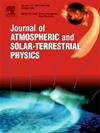偶发E的共轭半球不对称变化:风切变和流星离子的作用
IF 1.9
4区 地球科学
Q3 GEOCHEMISTRY & GEOPHYSICS
Journal of Atmospheric and Solar-Terrestrial Physics
Pub Date : 2025-04-30
DOI:10.1016/j.jastp.2025.106532
引用次数: 0
摘要
利用95°E经度两个磁共轭站7年的长期观测资料和HWM垂直风廓线,研究了流星离子沉降速率和垂直风切变对Es季节变化的影响。这两个观测站所选择的几何形状是这样的:南站(科科斯群岛,12.2°S, 96°N,地磁:21°S)在地理上处于低纬度,而北站(Dibrugarh, 27.5°N, 95°E,地磁:18°N)由于赤道向北倾斜而处于中纬度低纬度。统计观测结果显示,在低太阳活动期间,南低纬度站Es的季节特征几乎不变,而中低纬度站Es的夏季最大值则基本不变。Cocos上的低强度和高强度Es均与太阳活动呈负相关。然而,南站的高强度Es (>7 MHz)在至日更为频繁。在太阳活动高峰期,季节不保持不变性,最小值出现在三月分点。低(中)纬度台站的日(半日)振荡。纬向风的HWM垂直廓线显示,低纬度站风切变深度的季节变化不大,而中低纬度站最大风切变出现在夏季。对以往雷达观测资料的分析表明,赤道/低纬(中纬度)地区流星沉降速率最小(最大)季节与低纬(中)地区观测到的Es最小(最大)季节一致。因此,两个共轭站零星E (Es)的季节变化差异可以用风切变变化和流星沉降速率的联合机制来解释。本文章由计算机程序翻译,如有差异,请以英文原文为准。
Conjugate hemisphere asymmetric variation in sporadic E: Role of wind shear and meteor ions
The long-term (7 years) ionosonde observations of sporadic E (foEs) at two magnetically conjugate stations in the 95°E longitude, and the HWM vertical wind profiles are utilized to investigate the role of meteor ion deposition rates and vertical wind shear in the seasonal variation of Es. The chosen geometry of the two stations is such that southern station (Cocos islands,12.2°S, 96°N, geo-mag lat:21°S) is geographically at the low latitude, whereas the northern station (Dibrugarh 27.5°N, 95°E, geo-mag lat: 18°N) is at the low mid-latitude due to the north-shifted dip equator. The statistical observations show nearly invariant seasonal characteristics of Es at the southern low-latitude station (during low solar activity)in contrast to the summer maximum at the low mid-latitude station. Both low and high intensity Es over Cocos were found to be anti-correlated with solar activity. However, the high-intensity Es (>7 MHz) at the southern station is more frequent in the solstice. During the high solar activity period, the seasonal invariance is not maintained, and the minimum is recorded during the March equinox. The local time variation of foEs occurrence shows diurnal (semi-diurnal) oscillation at low (mid) latitude station. The HWM vertical profile of zonal winds show that wind shear depth at the low latitude station has low seasonal variation, whereas, at the low middle latitude station the maximum wind shear peaks during summer. Analysis of previously reported radar observations shows that the season of minimum (maximum) meteor deposition rate at equatorial/low-latitude (middle-latitude) regions are aligned with the observed season of minimum (maximum) of Es at low (middle) latitudes. Therefore, the difference of the seasonal variation of sporadic E (Es) at the two conjugate stations may be explained by a combined mechanism of wind shear variation and meteor deposition rates.
求助全文
通过发布文献求助,成功后即可免费获取论文全文。
去求助
来源期刊

Journal of Atmospheric and Solar-Terrestrial Physics
地学-地球化学与地球物理
CiteScore
4.10
自引率
5.30%
发文量
95
审稿时长
6 months
期刊介绍:
The Journal of Atmospheric and Solar-Terrestrial Physics (JASTP) is an international journal concerned with the inter-disciplinary science of the Earth''s atmospheric and space environment, especially the highly varied and highly variable physical phenomena that occur in this natural laboratory and the processes that couple them.
The journal covers the physical processes operating in the troposphere, stratosphere, mesosphere, thermosphere, ionosphere, magnetosphere, the Sun, interplanetary medium, and heliosphere. Phenomena occurring in other "spheres", solar influences on climate, and supporting laboratory measurements are also considered. The journal deals especially with the coupling between the different regions.
Solar flares, coronal mass ejections, and other energetic events on the Sun create interesting and important perturbations in the near-Earth space environment. The physics of such "space weather" is central to the Journal of Atmospheric and Solar-Terrestrial Physics and the journal welcomes papers that lead in the direction of a predictive understanding of the coupled system. Regarding the upper atmosphere, the subjects of aeronomy, geomagnetism and geoelectricity, auroral phenomena, radio wave propagation, and plasma instabilities, are examples within the broad field of solar-terrestrial physics which emphasise the energy exchange between the solar wind, the magnetospheric and ionospheric plasmas, and the neutral gas. In the lower atmosphere, topics covered range from mesoscale to global scale dynamics, to atmospheric electricity, lightning and its effects, and to anthropogenic changes.
 求助内容:
求助内容: 应助结果提醒方式:
应助结果提醒方式:


